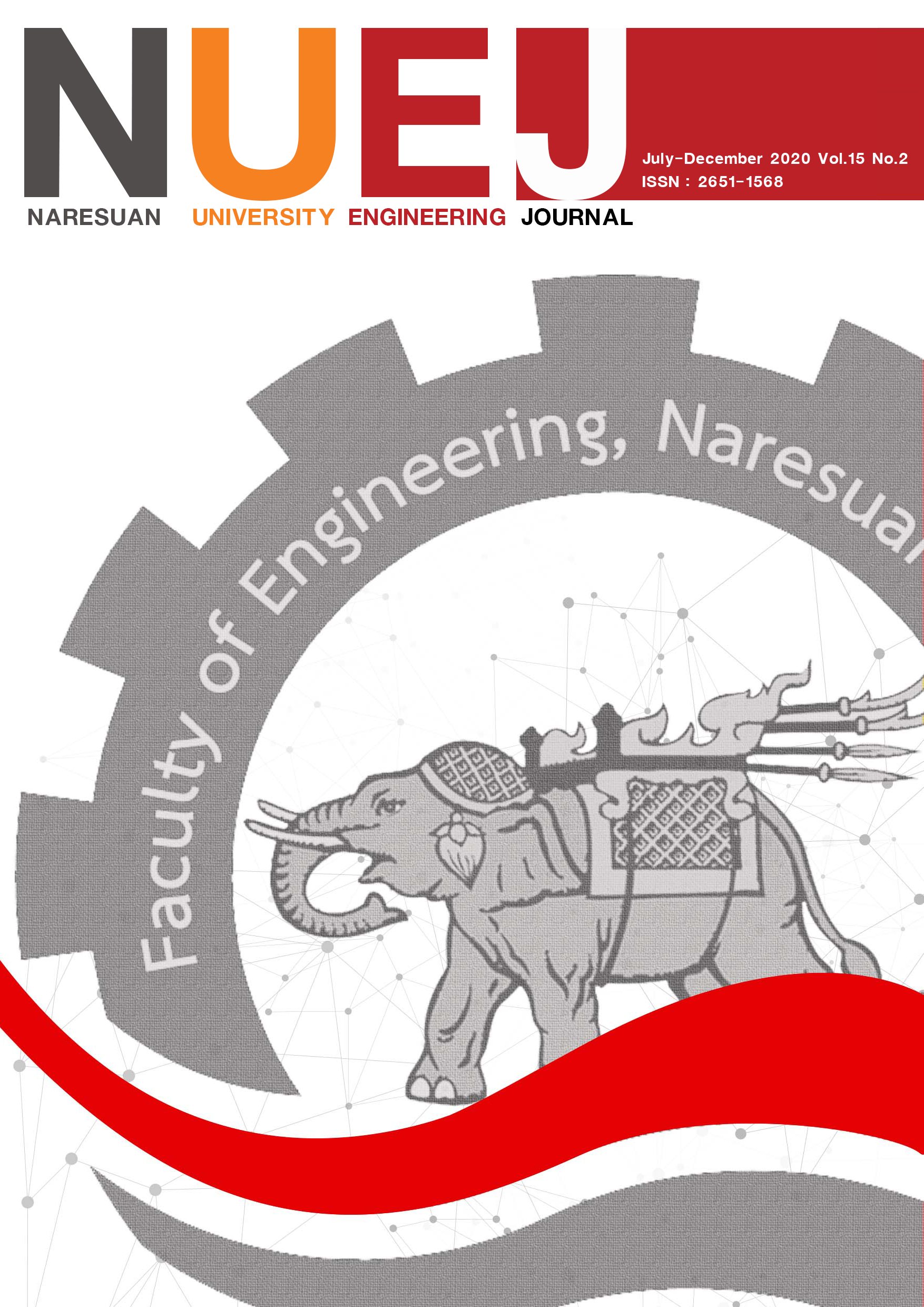โครงสร้างจุลภาคและสมบัติทางกลของอะลูมิเนียมหล่อกึ่งแข็งเกรด 2024 กับ 6061 ที่เชื่อมด้วยความเสียดทานแบบกวน
Main Article Content
บทคัดย่อ
งานวิจัยนี้มีวัตถุประสงค์เพื่อศึกษาการเชื่อมเสียดทานแบบกวนวัสดุต่างชนิดระหว่างอะลูมิเนียมผสมหล่อกึ่งของแข็ง 2024 กับ 6061 ซึ่งตัวอย่างมีขนาดความหนาของอะลูมิเนียม 4 มิลลิเมตร ความกว้าง 50 มิลลิเมตร และความยาว 100 มิลลิเมตร โดยการวิเคราะห์โครงสร้างจุลภาคและสมบัติทางกล ภายใต้ความเร็วหมุนเชื่อม 710 1000 และ 1400 รอบต่อนาที และความเร็วเดินเชื่อม 40 80 และ 112 มิลลิเมตรต่อนาที ผลการทดลองพบว่า สภาวะการเชื่อมเสียดทานแบบกวนที่ดีที่สุด ที่ความเร็วหมุนเชื่อมที่ 1000 รอบต่อนาที ความเร็วเดินเชื่อมที่ 112 มิลลิเมตรต่อนาที ซึ่งมีค่าความต้านทานแรงดึงและความแข็งสูงสุดในบริเวณแนวกวน เท่ากับ 190.4 MPa และ 137.0 HV ตามลำดับ นอกจากนี้โครงสร้างทางโลหะวิทยาของรอยเชื่อมมีลักษณะรอยเชื่อมที่กว้างเมื่อใช้ความเร็วหมุนเชื่อมสูง
Article Details
เอกสารอ้างอิง
Ali, A., Brown, M. W., Rodopoulos, C. A., & Gardiner, S. (2006). Characterization of 2024-T351 friction stir welding joints. Journal of Failure Analysis and Prevention, 6, 83-96.
Amancio-Filho, S. T., Sheikhi, S., Dos Santos, J. F., & Bolfarini, C. (2008). Preliminary study on the microstructure and mechanical properties of dissimilar friction stir welds in aircraft aluminium alloys 2024-T351 and 6056-T4.
Journal of Materials Processing Technology, 206, 132-142.
Amancio-Filho, S.T., Sheikhi, S., Dos Santos, J.F., & Bolfarini, C. (2008). Preliminary study on the microstructure and mechanical properties of dissimilar friction stir welds in aircraft aluminium alloys 2024-T351 and 6056-T4. Journal of Materials Processing Technology, 206, 132-142.
Babu, S., Janaki Ram, G.D., Venkitakrishnan, P.V., Madhusudhan Reddy, G. & Prasad Rao, K. (2011).
Microstructure and Mechanical Properties of Friction Stir Lap Welded Aluminum Alloy AA2014. Journal of Materials Processing Technology, 28, 414-426.
Boonchouytan, W., Cheewawuttipong, W., & Burapa, R. (2017). Microstructural Behavior and Mechanical Properties of Friction Stir Spot Welding of Dissimilar Aluminum Semi Solid Casting Sheets SSM2024 and SSM6061. Srinakharinwirot Engineering Journal, 12(2), 130-142.
Booth, D. P. P., Starink, M. J., & Sinclair, I. (2007). Analysis of local microstructure and hardness of 13 mm gauge 2024-T351 AA friction stir welds. Materials Science and Technology, 23, 276-284.
Caroline, J., Bruno de, M., Anne, D. & Aude, S. (2013). Torque, temperature and hardening precipitation evolution in dissimilar friction stir welds between 6061-T6 and 2014-T6 aluminum alloys. Journal of Materials Processing Technology, 213, 826-837.
Chen, Z. W., & Cui, S. (2008). On the forming mechanism of banded structures in aluminium alloy friction stir welds. Scripta Materialia, 58, 417- 420.
Ericsson, M. & Sandström, R. (2003). Influence of welding speed on the fatigue of friction stir welds, and comparison with MIG and TIG. International Journal of Fatigue, 25, 1379-1387.
Golestaneh, A.F., Aidy, A., & Zadeh, M. (2009). Modeling the fatigue crack growth in friction stir welded joint of 2024-T351 Al alloy. Materials and Design, 30, 2928-2937.
Gonçalo, S., Hao, W., Pedro, V., & Telmo, G.S. (2017). FSW of aluminum AA5754 to steel DX54 with innovative overlap joint. Weld World, 61, 257-268.
Hasan, J., Hadi, M., & Mohammad, H. (2019). Investigation of residual stress distribution of dissimilar Al-7075-T6 and Al-6061-T6 in the friction stir welding process strengthened with SiO2 nanoparticles. Journal of Manufacturing Processes, 43, 145-153.
Heidarzadeh, A., Khodaverdizadeh, H., Mahmoudi, A., & Nazari, E. (2012). Tensile behavior of friction stir welded AA 6061-T4 aluminum alloy joints. Materials and Design, 37, 166-173.
Kanwer, S., Arora, S. P., Michael, S., & Rajneesh, K. (2010). Effect of process parameters on friction stir welding of aluminum alloy 2219-T87. International Journal of Advanced Manufacture Technology, 50, 941-952.
Krishnan, K. N. (2002). On the formation of onion rings in friction stir welds. Materials Science and Engineering A, 327, 246-251.
Lockwood, W.D., Tomaz, B. & Reynolds, A.P. (2002). Mechanical response of friction stir welded AA 2024: Experiment and modelling. Materials Science and Engineering A, 323, 348-353.
Sadeesh, P., Venkatesh, K.M., Rajkumar, V., Avinash, P., Arivazhagan, N., Devendranath, Ramkuma,r K. & Narayanan, S. (2014). Studies on friction stir welding of AA 2024 and AA 6061 dissimilar metals. Procedia Engineering, 75, 145-149.
Shen, Z., Chen, Y., Haghshenas, M., & Gerlich, A. P. (2015). Role of welding parameters on interfacial bonding in dissimilar steel/aluminum friction stir welds. Engineering Science and Technology, an International Journal, 18, 270-277.
Shusheng, D., Xinqi, Y., Guohong, L., & Bo, J. (2006). Comparative study on fatigue properties between AA2024-T4 friction stir welds and base materials. Materials Science and Engineering A, 435-436, 389-395.
Ying, L., Murr, L.E., & Mc Clure, J.C. (1999). Flow visualization and residual microstructures associated with the friction-stir welding of 2024 aluminum to 6061 aluminum. Materials Science and Engineering: A, 271, 213-223.
Zhang, Z., Xiao, B. L., & Ma, Z. Y. (2012). Effect of welding parameters on microstructure and mechanical properties of friction stir welded 2219Al-T6 joints. Journal of Materials Science, 47, 4075-4086.


